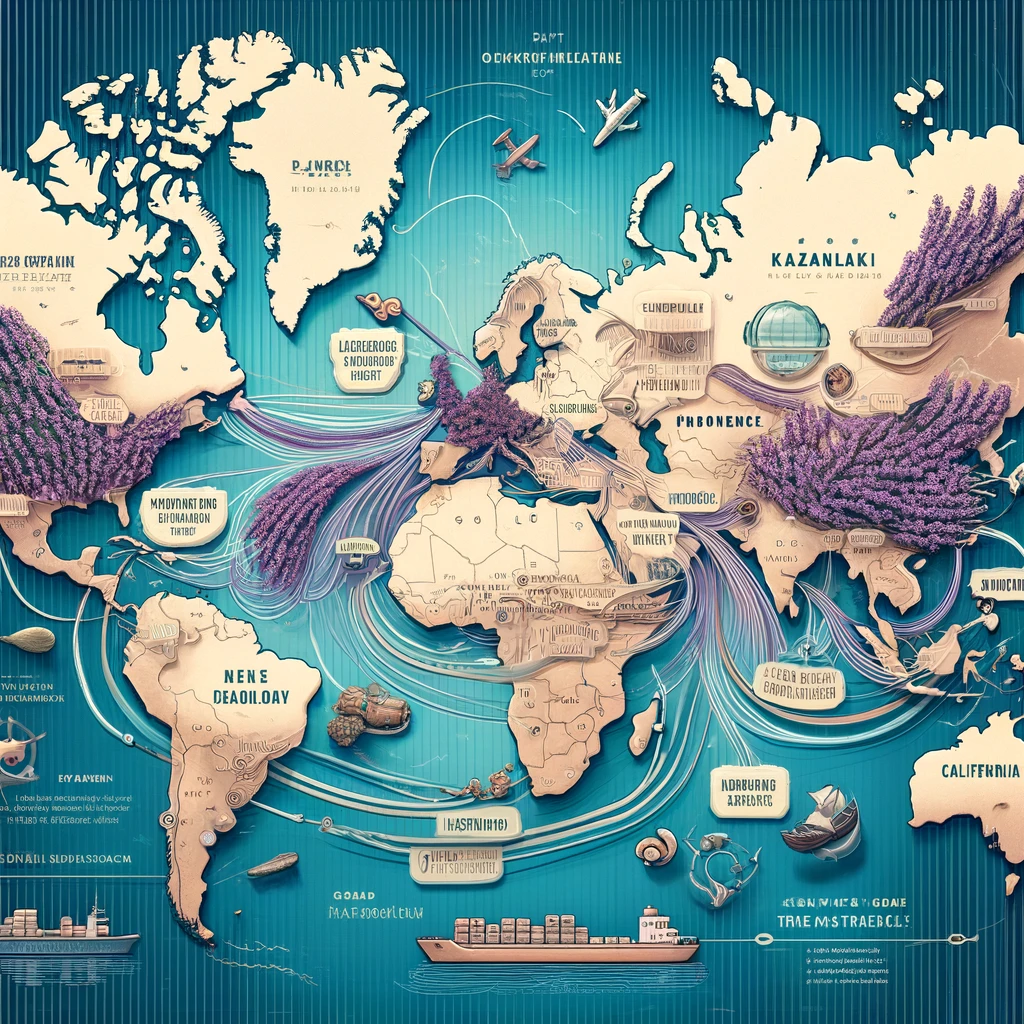Economic and Commercial Impact of Lavender
Global Trade and Market Dynamics
Lavender, a perennial favorite in the realms of aromatherapy, cosmetics, and cuisine, has not only carved a niche in various industries but also significantly impacted global markets and trade dynamics. The cultivation and sale of lavender have evolved into a multimillion-dollar industry, with France, Bulgaria, and the United States leading as top producers. This section delves into the intricate trade routes, market trends, and the broader economic implications of lavender’s global trade.
Trade Routes and Production Centers
Lavender’s journey from local fields to global markets begins in the picturesque landscapes of Provence, France, and the valley of Kazanlak in Bulgaria—regions synonymous with extensive lavender farming. These areas are regarded as the heart of lavender oil production due to their favorable climate and soil conditions, which are ideal for cultivating high-quality lavender. The United States, particularly Washington and California, has also seen a rise in lavender farming, catering primarily to the domestic market.
The trade routes for lavender and its products (essential oils, dried flowers, and culinary products) span across continents, with Europe being the largest exporter. The distribution channels are well-established, involving farmers, distillers, wholesalers, and retailers, culminating in the product reaching consumers worldwide.
Market Trends
The global market for lavender oil alone is projected to reach significant growth by 2025, driven by increasing consumer preference for natural and organic products in cosmetics and essential oils. The versatility of lavender has allowed it to maintain a stable and growing presence in the market. Trends indicate a rising popularity in developing regions such as Asia-Pacific, where wellness and natural health products are gaining traction.
The demand for lavender is also influenced by its seasonal popularity. For instance, lavender-related products see a surge in sales during spring and summer, aligning with its bloom season and increased tourist activities in lavender-rich regions like Provence, which is famous for its lavender tours.
Economic Impact
Lavender contributes significantly to the local economies of production regions. In Provence, for instance, lavender farming and the related tourism are crucial economic pillars. The industry not only supports agriculture but also stimulates local businesses including hospitality, retail, and transportation.
Farmers and producers are increasingly turning to organic and sustainable practices, responding to consumer demands and regulatory standards, which adds value to the lavender products and can potentially increase market prices. Moreover, the cultivation of lavender supports biodiversity and helps in maintaining the ecological balance, adding to its environmental value.
Product Innovation
The adaptability and appeal of lavender have spurred innovation across several industries, particularly in cosmetics, therapeutics, and culinary arts. Each sector has embraced lavender, creating products that highlight its benefits and meet the evolving needs and preferences of consumers.
Cosmetics
In the cosmetic industry, lavender is prized for its antiseptic and anti-inflammatory properties, making it a preferred ingredient in skincare. Recent innovations include lavender-infused serums, facial toners, and anti-aging creams. These products cater to a growing segment of consumers looking for skincare that is not only effective but also gentle and derived from natural sources.
Lavender’s soothing properties are leveraged in body care products as well, such as lotions, bath salts, and body washes, designed to provide a calming experience. Moreover, the introduction of lavender in hair care products, like shampoos and conditioners for scalp health, underscores its versatility.
Therapeutics
The therapeutic sector has seen significant innovations with lavender. Its stress-relieving and anxiolytic effects are encapsulated in essential oils and diffusers, which are mainstreamed for home and clinical use. Beyond aromatherapy, lavender is being incorporated into herbal supplements and sleep aids, including teas and capsules, aimed at enhancing relaxation and sleep quality.
Culinary Field
Lavender’s entry into the culinary world has been marked by its inclusion in a variety of foods and beverages. From lavender-infused honey, chocolates, and ice creams to gourmet culinary pastes and spices used in cooking, the herb adds a distinctive flavor and appeal to dishes. Additionally, lavender-flavored beverages, including teas, lemonades, and even alcoholic drinks like lavender gin and beer, are growing in popularity, expanding lavender’s presence in the culinary arts.
Conclusion
Lavender’s influence on global markets and its integration into diverse product lines illustrate its significant economic and commercial impact. As markets continue to evolve and consumer preferences shift towards more natural and sustainable products, the demand for lavender is likely to increase, fostering further innovation and economic growth in regions that cultivate and produce lavender-based products. This enduring herb not only enriches our senses and health but also plays a pivotal role in the economic landscapes of many communities worldwide.

Here is a detailed and informative map illustrating the global trade routes of lavender. It highlights key production areas like Provence in France, Kazanlak in Bulgaria, and regions in the United States such as Washington and California. The map shows the flow of lavender and its products to various parts of the world, including Europe, Asia, and North America, using symbols and lines to depict the routes and areas of high production. Modes of transport like ships and planes are also represented to show how lavender is moved globally.
